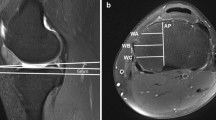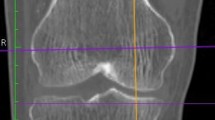Abstract
Unicondylar knee arthroplasty (UKA) has gained popularity in the recent years for treating medial compartment osteoarthritis of the knee joint in the Asian population. There is little information about the anthropometry of the resected bony surfaces of the knee joint in these population groups for designing the appropriate size-matched UKA components. We studied the anthropometry of the resected medial tibial condyles in 50 male and 50 female Korean cadavers by using three-dimensional computer tomography. We measured the anteroposterior dimension, the mediolateral dimension at defined points and the condylar aspect ratio. These measurements were compared with similar dimensions of the tibial components from five conventionally used UKA designs. Statistical analysis was performed using Student’s t-test, Paired t-test and Pearson’s correlation coefficient. We found that three of the tibial component designs showed mediolateral overhang for the whole range of measured anteroposterior dimensions of the resected medial tibial condyles, whereas one of the designs (DePuy) showed mediolateral undersizing for the smaller AP dimensions and overhang for the larger AP dimensions of the resected medial tibial condyles. Another design (Smith and Nephew) showed mediolateral undersizing for the whole range of measured anteroposterior dimensions of the resected medial tibial condyle. We found a decrease in the condylar aspect ratio with increasing AP dimension for our cadaver population data. However, the majority of the conventional tibial prosthesis showed either a constant condylar aspect ratio or an increasing aspect ratio (DePuy) with the increasing AP dimension of the resected medial tibial condyle. Our study may provide guidelines for designing appropriate tibial UKA components for a majority of Asian sub-populations and encourage similar studies in other population groups.





Similar content being viewed by others
References
Berger RA, Nedeff DD, Barden RM, Sheinkop MM, Jacobs JJ, Rosenberg AG, Galante JO (1999) Unicompartmental knee arthroplasty: clinical experience at 6- to 10-year followup. Clin Orthop 367:50–60
Carr A, Keyes G, Miller R, O’Connor J, Goodfellow J (1993) Medial unicompartmental arthroplasty: a survival study of the Oxford meniscal knee. Clin Orthop 295:205–213
Deshmukh RV, Scott RD (2001) Unicompartmental knee arthroplasty: long-term results. Clin Orthop Relat Res 392:272–278
Dorr LD, Boiardo RA (1986) Technical considerations in total knee arthroplasty. Clin Orthop Relat Res 205:5
Hitt K, Shurman JR II, Greene K, McCarthy J, Moskal J, Hoeman T, Mont MA (2003) Anthropometric measurements of the human knee: correlation to the sizing of current knee arthroplasty systems. J Bone Joint Surg Am 85:115–122
Keyes GW, Carr AJ, Miller RK, Goodfellow JW (1992) The radiographic classification of medial gonarthrosis: correlation with operation methods in 200 knees. Acta Orthop Scand 63:497–501
Murray DW, Goodfellow JW, O’Connor (1998) The oxford medial unicompartmental arthroplasty: a ten-year survival study. J Bone Joint Surg Br 80:983–989
Rougraff BT, Heck DA, Gibson AE (1991) A comparison of tricompartmental and unicompartmental arthroplasty for the treatment of gonarthrosis. Clin Orthop 273:157–164
Uehara K, Kadoya Y, Kobayashi A, Ohashi H, Yamano Y (2002) Anthropometry of the proximal tibia to design a total knee prosthesis for the Japanese population. J Arthroplasty 17:1028–1032
Vaidya SV, Ranawat CS, Aroojis A, Laud NS (2000) Anthropometric measurements to design total knee prostheses for the Indian population. J Arthroplasty 15:79–85
Acknowledgements
This study was supported by the Project of Knowledge Information Management 2005 from the Ministry of Information and Communication (MIC), and the Korea Institute of Science and Technology Information (KISTI). Dr. CW Han received scholarship support from the Brain Korea 21 Project.
Author information
Authors and Affiliations
Corresponding authors
Additional information
D. S. Kwak and S. Surendran contributed equally to this work.
Rights and permissions
About this article
Cite this article
Surendran, S., Kwak, D.S., Lee, U.Y. et al. Anthropometry of the medial tibial condyle to design the tibial component for unicondylar knee arthroplasty for the Korean population. Knee Surg Sports Traumatol Arthrosc 15, 436–442 (2007). https://doi.org/10.1007/s00167-006-0188-5
Received:
Accepted:
Published:
Issue Date:
DOI: https://doi.org/10.1007/s00167-006-0188-5




